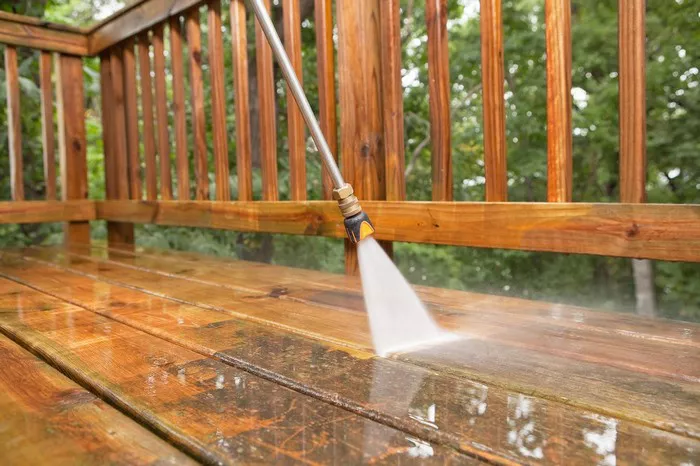Proper drying after power washing a deck is essential to ensure the longevity and aesthetics of the wood. Neglecting this crucial step can lead to a host of problems, including improper adhesion of stains or sealers, which can result in a blotchy, uneven finish and potentially significant wood damage over time. Understanding the drying process and the factors that influence it will help you maintain your deck’s beauty and structural integrity for years to come.
In this article, we will discuss the recommended drying time for a deck after power washing, the various factors that can affect this drying period, and how to ensure your deck is completely dry before you proceed with staining or sealing. Adhering to these guidelines will help you achieve the best possible results and avoid common pitfalls associated with wet wood treatment.
See also: Pressure Washer Pump Types
General Drying Time Recommendation
A minimum recommended drying time for a deck after power washing is typically around 48 hours. This general guideline allows enough time for most of the surface moisture to evaporate, leaving the wood ready for staining or sealing. However, this time frame can vary significantly based on several factors, which we will discuss in detail below.
The 48-hour recommendation is not a one-size-fits-all rule. Decks in different environments and conditions will require different drying times. It’s crucial to consider the specific circumstances surrounding your deck to determine the appropriate drying period accurately. Rushing this process can lead to suboptimal results, such as uneven staining, poor adhesion, and reduced durability of the sealant.
Factors Affecting Drying Time
Weather Conditions
Temperature: Temperature plays a pivotal role in the drying process of a deck. Warmer temperatures accelerate the evaporation of moisture from the wood. Ideally, the temperature should be above 50°F (10°C) for optimal drying. In hotter climates, drying times can be shorter, while cooler temperatures will extend the drying period. If you live in a region with fluctuating temperatures, it’s best to monitor the weather forecast and choose a period of consistent warm weather for power washing and drying your deck.
Humidity: Humidity levels directly affect the drying time of a deck. Higher humidity means there is more moisture in the air, which slows down the evaporation process. In contrast, low humidity promotes faster drying. Ideally, you want to power wash your deck during a period of low to moderate humidity to ensure the wood dries efficiently. Using a hygrometer can help you monitor the humidity levels and choose the best time for your project.
Shade vs. Sun: Exposure to sunlight significantly impacts the drying time of your deck. Decks located in full sun will dry much faster than those in shaded areas. Sunlight not only heats the wood but also facilitates the evaporation of water. If parts of your deck are shaded, they will naturally take longer to dry. Consider trimming nearby trees or shrubs to increase sunlight exposure if possible, or use fans to help increase airflow in shaded areas.
Airflow: Good air circulation is crucial for efficient drying. Stagnant air can trap moisture on the surface of the wood, prolonging the drying time. If your deck is located in an area with poor natural airflow, consider using portable fans to promote air movement. This can be particularly useful in shaded or enclosed spaces where natural ventilation is limited.
Wood Moisture Content Before Cleaning
The initial moisture content of the wood before power washing can also affect the drying time. If your deck was already wet or damp before cleaning, it will take longer to dry completely. Conversely, if the wood was dry before washing, the drying process will be quicker. Using a moisture meter before starting the power washing process can help you assess the initial moisture content and better estimate the drying time required.
See also: Can You Use a Pressure Washer to Clean Your House Exterior?
Verifying Complete Drying
Moisture Meter
To ensure your deck is completely dry before staining or sealing, using a moisture meter is the most accurate method. A moisture meter measures the moisture content within the wood, providing a precise reading. For most wood types, a moisture content of 12-15% or lower is considered acceptable for staining or sealing. By using a moisture meter, you can avoid guesswork and ensure the wood is adequately dry, which helps achieve the best results with your chosen finish.
Alternative Methods
In the absence of a moisture meter, there are other ways to check if your deck is dry. One common method is the touch test – simply feeling the wood for any remaining dampness. While this method is less precise than using a moisture meter, it can still give you a good indication of the deck’s dryness. Another technique is to tape a small piece of plastic (like a zip-lock bag) to the deck’s surface and leave it for a few hours. If condensation forms inside the plastic, the wood is still damp and needs more time to dry.
Conclusion
Reiterating the importance of allowing your deck to dry completely after power washing cannot be overstated. Proper drying ensures that stains and sealers adhere correctly, providing a uniform appearance and maximum protection against the elements. To promote faster drying, aim to power wash your deck on sunny days with good ventilation and low humidity. Monitoring the drying process with a moisture meter or alternative methods will help you determine the right time to proceed with staining or sealing.
For optimal results and to avoid potential issues, always consider consulting a professional if you are unsure about any aspect of the drying or finishing process. Professionals have the experience and tools necessary to ensure your deck is treated correctly, extending its life and maintaining its beauty.
By following these guidelines and paying close attention to the drying process, you can enjoy a beautifully finished deck that will withstand the test of time and weather, enhancing the outdoor appeal and functionality of your home.

